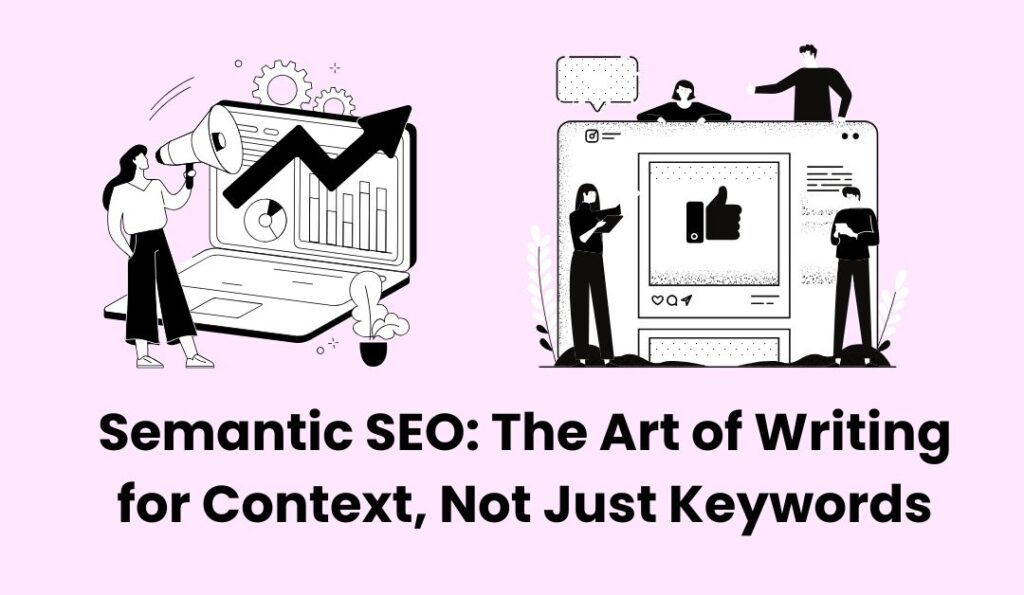Introduction to Semantic SEO
Imagine you’re telling a story to a friend. You don’t just use single words—you explain details, share examples, and give clues so your friend truly understands what you mean. That’s what semantic SEO is all about: writing for meaning and context, not just stuffing pages with keywords. Whether you’re a blogger, a small business owner, or part of one of the many SEO companies in Chennai, learning to write with context can boost your search rankings and keep readers happy.
What Is Semantic SEO?
Semantic SEO focuses on understanding the purpose behind a search query. Instead of zeroing in on an exact keyword phrase, you think about the topic broadly: related questions, synonyms, and the user’s intent. For example, if someone searches “best cake recipes,” semantic SEO would cover ingredients, baking tips, and even decorating ideas—everything that helps answer the question fully.
Why Context Matters More Than Keywords
- User Satisfaction: Search engines want users to leave happy. If someone finds a page that answers not only their main question but also related ones, they stay longer and engage more.
- Reduced Bounce Rate: When your content addresses context, visitors click around your site to learn more. A lower bounce rate signals to search engines that your content is valuable.
- Long-Term Value: Pages that cover a topic deeply often stay relevant longer. With purely keyword-focused pages, you may outrank others briefly, but when search engines update their algorithms, those pages can lose visibility fast.
How Search Engines Understand Meaning
Modern search engines use artificial intelligence and natural language processing to “read” your content almost like a person would. Two key techniques include:
- Entity Recognition: Search engines identify entities—people, places, companies, or concepts. For example, “apple” can refer to a fruit, a company, or even a record label.
- Latent Semantic Indexing (LSI): This method groups related words and phrases. If your page talks about “baking,” you might naturally include “oven,” “flour,” and “recipes,” which tells search engines you’re covering the topic fully.
Crafting Content for Context
Here are some simple steps to start writing for context:
1. Research Related Questions
- Use tools like AnswerThePublic or the “People also ask” box on Google.
- Jot down common questions and subtopics.
2. Outline Your Article with Topic Clusters
- Begin with the main question or topic at the top.
- Group related ideas under clear headers. For instance, under “How to Bake a Cake,” you might have “Choosing the Right Ingredients” and “Decorating Hacks.”
3. Write Conversationally
- Imagine you’re explaining to a friend. Use simple words and friendly examples.
- Avoid jargon unless you explain it.
4. Use Synonyms and Natural Language
- Instead of repeating the same phrase, sprinkle in synonyms. For “bake a cake,” you could say “prepare a sponge,” “mix your batter,” or “preheat the oven.”
- This helps search engines see that you understand the topic deeply.
5. Answer Related Queries
- If your main focus is “cake recipes,” you can add a section on “Storage Tips” or “Quick Frosting Ideas.”
- This enriches your content and keeps readers on your page.
Practical Example: A Simple Semantic SEO Outline
- Title: Easy Homemade Cake Recipes for Beginners
- Introduction: Why baking at home is fun and rewarding (include “SEO companies in Chennai” naturally if writing for a client in Chennai).
- Choosing Ingredients
- Step-by-Step Baking Guide
- Decorating Tips and Tricks
- Frequently Asked Questions
- Storage and Serving Ideas
- Conclusion
By organizing content this way, you cover the main topic plus valuable details that users often seek.
Tools to Help You Master Semantic SEO
- Keyword Research Tools: Ahrefs, SEMrush, or Ubersuggest to find related keywords and questions.
- Content Optimization Tools: Clearscope or Surfer SEO analyze top-ranking pages and suggest related terms.
- AI Writing Assistants: Tools like ChatGPT can help brainstorm topic clusters or rephrase sentences in simpler language.
Measuring Your Success
Once your content is live, keep an eye on these metrics:
- Organic Traffic: Are more people finding your page through search?
- Time on Page: Do readers spend enough time absorbing your content?
- Bounce Rate: Are visitors exploring beyond the first page?
- Ranking Improvements: Track how your page ranks for various related queries, not just the main keyword.
Common Mistakes to Avoid
- Keyword Stuffing: Overusing a phrase makes content sound robotic.
- Ignoring User Intent: Writing only for search engines, not for people, leads to high bounce rates.
- Shallow Coverage: One-paragraph articles rarely satisfy users. Aim for depth and clarity.
Bringing It All Together
Semantic SEO isn’t about abandoning keywords—it’s about seeing them in a bigger picture. By focusing on context and user intent, you create content that search engines love and readers enjoy. Remember to research related questions, write conversationally, and use tools to guide your topic clusters.
When your pages answer not just the main question but anticipate follow-up questions, you build trust with your audience. That trust leads to more shares, backlinks, and better rankings over time.
Quality content that informs, engages, and solves problems is the heart of semantic SEO. By mastering the art of writing for context, you’ll stand out in search results and deliver real value to your readers—whether you’re a global brand or a local Digital Marketing company in Chennai.
- Semantic SEO: The Art of Writing for Context, Not Just Keywords
- Master Semantic SEO by writing for context, not just keywords. Boost rankings with user-focused content that search engines and readers love.
- Digital Marketing company in Chennai, SEO companies in Chennai
Related posts:
 Machinery and Equipment Industry Email List: Unlocking Opportunities for B2B Marketing Success
Machinery and Equipment Industry Email List: Unlocking Opportunities for B2B Marketing Success
 Essentials Hoodie with Bold Logo – A Modern Streetwear Icon for Everyday Style”
Essentials Hoodie with Bold Logo – A Modern Streetwear Icon for Everyday Style”
 Why Investing in Charlotte SEO Is Crucial for Business Growth
Why Investing in Charlotte SEO Is Crucial for Business Growth
 ways to oversee living where you work ways to oversee living where you work
ways to oversee living where you work ways to oversee living where you work
 Retirement Arranging in Singapore: Retirement Arranging in Singapore:
Retirement Arranging in Singapore: Retirement Arranging in Singapore:
 Transform Your Business with Lahore’s Top Digital Services | Hiline Digital
Transform Your Business with Lahore’s Top Digital Services | Hiline Digital
 Elevate Your Web Applications with Professional Angular JS Development Services
Elevate Your Web Applications with Professional Angular JS Development Services
 Comme des Garcons and Sp5der: Streetwear’s Most Buzziest Brands of 2025
Comme des Garcons and Sp5der: Streetwear’s Most Buzziest Brands of 2025







